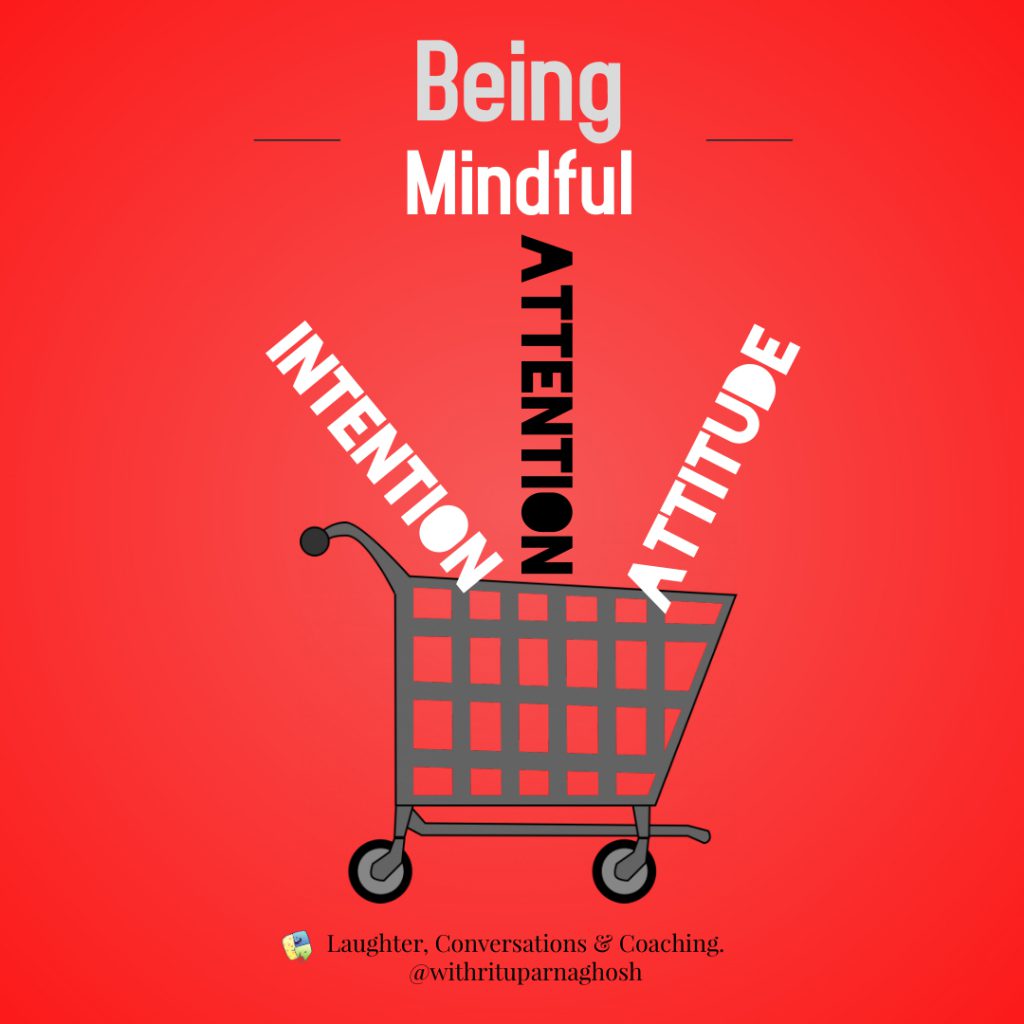There are two more posts in the ‘expectations’ series coming your way. I’ve been distracted a lot by other things happening and before I knew it, focusing on being mindful about writing a post resulted in this post 😉
Most often, when we hear the word Mindfulness, our immediate thoughts head to meditation. We imagine Mindfulness as sitting in a corner, deep in meditation, our minds blissfully empty of any anxiety or worrisome thoughts. Few of us, freaked out of the image, walk away immediately, ironically (read on to know why) saying they don’t have time for this. Few of us who are adventurous enough to try the mindful meditative path give up after few tries because as much as they try, their minds cannot be empty!
But what if I tell you, Mindfulness is not only sitting in a corner and meditating, but instead you can do whatever you do, yet be mindful?
How?
Simply by being present, by focusing on the task at hand, being one with it, and not getting distracted by the thousand and one thoughts rumbling in your brain. Mindfulness can feel like a flow – What are you doing? – Intention, what is the task at hand? – Attention and How are you doing it? – Attitude.
In layman’s language, being mindful is to get your attention back to the activity at hand. How many times we’ve come to a scenario – we open our laptops intending to respond to an urgent email, only to worry about what else might we need to do or get distracted by an innocuous message from a colleague. Result? A trip down a rabbit hole of who, what, when before we know, we forget to write some of the stuff you needed to respond with, causing us to waste our already valuable time on redoing (remember the irony?).
Distractions take us away from our goal; that is the reason they are called a distraction. With globalisation and the arrival of smart phones, there is no limit to distractions. Friends, colleagues, managers, there are countless messages, pings, emails, each with an agenda different than yours. So, then the million-dollar question is, how do we continue to be mindful in the face of growing distractions?
Step 1 – set your intention – Why do you want to be mindful? What has brought you to this blog and made you read this far? It could be your everyday work stress. It could be a lesson in your personal growth. It could be a realisation that you’ve started to live life on autopilot.
Step 2 – Attention – Once the intent to be mindful is in place, how will you give your attention to this task? A good starting point is to accept and acknowledge that the mind will wander. A new study shows humans have 6,200 thoughts per day. That’s 4.5 thoughts a minute! But what do you do when the mind goes off chasing one? The trick is to get it back. In the beginning, we might have to do this multiple times, but slowly with practice, you’d build the focus.
Step 3- Attitude – Intrinsic to the task in hand is how we do it. What is your attitude you bring to it? Handling things with acceptance, openness, curiosity, and kindness more often than not helps you get to the state of flow. Sometimes, it is challenging to be non-judgemental and open with self, especially when you constantly fear missing out, forgetting something. Getting your attention back to not only the task but also being kind to yourself will help.
Over time, each component supports the other – your kind attitude towards yourself will boost your self-confidence and directly strengthen your intention. You will then be able to be a lot more attentive about what you are doing and not scattered with worry, less thoughts in your head.
What would being mindful give us?
Being present with the task in hand is a sure shot way to increase productivity. Studies show that the age-old belief that multitasking increases productivity is not valid because there is no such thing as multitasking!
David Meyer, professor of psychology at the University of Michigan, says, “Once you start to make things more complicated, things get messier, and as a result, there’s going to be interference with one or more of the tasks. Either you’re going to have to slow down on one of the tasks, or you’re going to start making mistakes.”
Mr. Meyer might just be hinting at the tip of an iceberg here, but that’s a story for another day. Being mindful gives you the ability to give yourself entirely to one task before moving on to the next. There is no concentration leakage in switching between windows, worrying that you might have missed something or a hindrance to your state of flow.
Having your complete focus on the task at hand helps you focus on all the tiny details, which further creates a sense of calm and less anxious workspace.
Last but not least, Mindfulness boosts creativity. I know there is only so much creative we can get on office documents/emails, but being mindful helps develop a farsighted perspective and helps avoid rework.
So, what are you waiting for?

